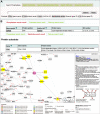The human DEPhOsphorylation database DEPOD: a 2015 update
- PMID: 25332398
- PMCID: PMC4383878
- DOI: 10.1093/nar/gku1009
The human DEPhOsphorylation database DEPOD: a 2015 update
Abstract
Phosphatases are crucial enzymes in health and disease, but the knowledge of their biological roles is still limited. Identifying substrates continues to be a great challenge. To support the research on phosphatase-kinase-substrate networks we present here an update on the human DEPhOsphorylation Database: DEPOD (http://www.depod.org or http://www.koehn.embl.de/depod). DEPOD is a manually curated open access database providing human phosphatases, their protein and non-protein substrates, dephosphorylation sites, pathway involvements and external links to kinases and small molecule modulators. All internal data are fully searchable including a BLAST application. Since the first release, more human phosphatases and substrates, their associated signaling pathways (also from new sources), and interacting proteins for all phosphatases and protein substrates have been added into DEPOD. The user interface has been further optimized; for example, the interactive human phosphatase-substrate network contains now a 'highlight node' function for phosphatases, which includes the visualization of neighbors in the network.
© The Author(s) 2014. Published by Oxford University Press on behalf of Nucleic Acids Research.
Figures


References
-
- Xue Y., Gao X., Cao J., Liu Z., Jin C., Wen L., Yao X., Ren J. A summary of computational resources for protein phosphorylation. Curr. Protein Pept. Sci. 2010;11:485–496. - PubMed
-
- Li X., Wilmanns M., Thornton J., Köhn M. Elucidating human phosphatase–substrate networks. Sci. Signal. 2013;6:rs10. - PubMed
-
- Hatzihristidis T., Liu S., Pryszcz L., Hutchins A.P., Gabaldón T., Tremblay M.L., Miranda-Saavedra D. PTP-central: a comprehensive resource of protein tyrosine phosphatases in eukaryotic genomes. Methods. 2014;65:156–164. - PubMed
-
- Liberti S., Sacco F., Calderone A., Perfetto L., Iannuccelli M., Panni S., Santonico E., Palma A., Nardozza A.P., Castagnoli L., et al. HuPho: the human phosphatase portal. FEBS J. 2013;280:379–387. - PubMed
Publication types
MeSH terms
Substances
LinkOut - more resources
Full Text Sources
Other Literature Sources
Research Materials

